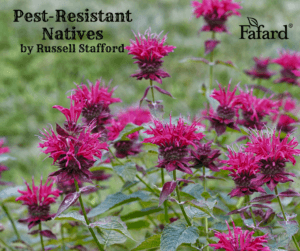
American gardeners who want to incorporate more native perennials into their plantings often come into conflict with two other native species: white-tailed deer and Eastern cottontail. Unlike many native plants, these vegetation-munching critters find suburban neighborhoods and other domesticated landscapes to be ideal “natural” habitats. This especially goes for one of their favorite suburban microhabitats – perennial plantings. What tastier delicacy than a lush phlox or coreopsis or other perennial favorite?
Rabbits and deer find some perennials to be anything but toothsome, however. Here are some to consider for your nibbler-infested garden. Most will remain largely unscathed even in areas with swarms of pests. The goldenrods are one exception, as they may be on the menu where herbivore pressure is intense.
Bee balm (Monarda spp.)
Deer and rabbits tend to steer clear of plants with strongly aromatic foliage. Consequently, many of the most pest-resistant perennials belong to the mint family – including everything in the genus Monarda. Best known to gardeners in the form of large 3-foot-plus hybrids such as brilliant red-flowered ‘Jacob Cline’ and purple-red ‘Raspberry Wine’, bee balms come in many other colors and sizes. One of the best is the Midwest native Bradbury’s bee balm (Monarda bradburiana). Its lilac-pink flowers open a month before the hybrids bloom, on 15-inch plants that clump rather than romp. The mildew-resistant foliage flushes deep bronze-purple in early spring. Similar in flower color but blooming a month later on 4-foot stems, wild bergamot (Monarda fistulosa) ranges over a wide area of eastern and central North America. It also spreads widely in any good garden soil. All of the above would appreciate a hit of Fafard Organic Compost, especially if your soil has lots of sand or clay. In contrast, horsemint (Monarda punctata) prefers garden conditions more akin to the dry, sandy habitats where it occurs naturally. It’s fascinating pink-collared whorls of yellow flowers attract numerous beneficial pollinators in summer, while its oregano-scented foliage repels herbivores. This spreading, 30-inch-tall, short-lived perennial is native to much of North America, from coast to coast.

Mountain mints (Pycnanthemum spp.) and anise hyssop (Agastache foeniculum)
We profiled these fragrant-leaved mint family members in May in an article on edible natives. Edible for humans, that is; for deer and rabbits, they’re just the opposite. One Agastache we didn’t profile last month – yellow giant hyssop (Agastache nepetoides) – is equally pest-resistant and pollinator-friendly. An architectural 4- to 6-foot perennial from eastern and central North America, it triggers a pollinator feeding frenzy with its summer spikes of small yellow flowers. They evolve to elongated dark-gray seedheads, which make an ornamental statement in fall and winter. Most Agastache are enthusiastic self-sowers, so be on the lookout for volunteer seedlings. Mountain mints also spread widely, by underground rhizomes and sometimes by seed.
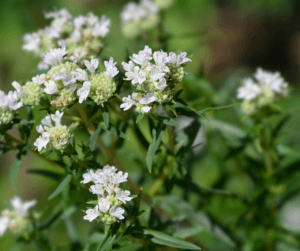
Beardtongues (Penstemon spp.)
Beloved by hummingbirds and bumblebees, Penstemon are native exclusively to North America, in a wide range of regions and habitats. Deer and rabbits avoid all 250-plus members of the genus. Most Central and Eastern U.S. beardtongues (such as P. digitalis and P. smallii) produce spires of white or pink/purplish flowers on 2- to 4-foot stems in late spring or early summer. Western species flower in a much wider range of colors, including blue, red, and the occasional yellow. Unfortunately, Westerners are also typically mountain-dwellers that loathe heat and dampness. Exceptions such as violet-blue-flowered Penstemon strictus do just fine in the Eastern lowlands provided the soil isn’t too heavy or damp.
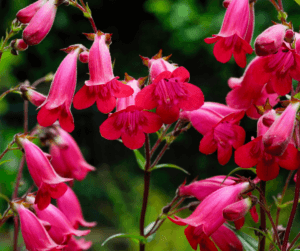
Bluestars (Amsonia spp.)
The handsome lance-shaped foliage of these stalwart perennials is seemingly immune from diseases and pests. Native mostly to the southeastern and central U.S., bluestars owe their common name to their clusters of narrow-petaled flowers that open in late spring or early summer. Until recently, Eastern bluestar (Amsonia tabernaemontana) – including its narrow-leaved and compact forms (salicifolia and montana) – was the most commonly grown species. That honor now surely belongs to threadleaf bluestar (A. hubrichtii), prized for its fine-textured, narrow foliage borne on dense 42-inch plants. Also worth growing, are other U.S. native amsonias including shining bluestar (A. illustris) and stiff bluestar (A. rigida). All of them turn eye-catching yellow shades in fall.
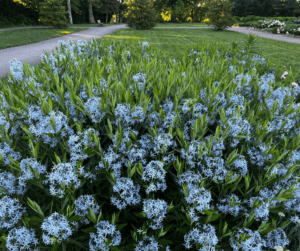
Goldenrods (Solidago spp. etc.)
Often dismissed wholesale as rampant weeds, goldenrods offer numerous well-behaved species in a diversity of shapes and sizes. They are also pest-resistant – although you can expect some damage in heavily browsed areas. Perhaps the most pest resistant of the tribe is sweet goldenrod (Solidago odora), whose anise-like fragrance and flavor is off-putting to bunnies and deer. Other noteworthy species include stiff goldenrod (S. rigida), which flaunts large, handsome, gray-green basal leaves and domed heads of yellow flowers; and showy goldenrod (S. speciosa), with arrestingly large panicles of golden yellow on statuesque stems. There is even a white-flowered species, silverrod (S. speciosa), also notable for the graceful form of its narrow upright inflorescences on 2-foot stems. These and other goldenrods are essential late-summer bloomers, attracting swarms of bumblebees and other pollinators. And no – they do not cause hay fever.

Bugbane (Actaea spp.)
Formerly known botanically as Cimicifuga, these pollinator favorites make excellent architectural subjects for partial shade. Northeast and Central U.S. native black bugbane (Actaea racemosa) forms large lacy clumps of divided leaves, topped by statuesque spires of frothy white flowers in midsummer. Appalachian bugbane (A. rubifolia) is bolder in texture, later in flower, and somewhat more compact in habit than black bugbane. Its dense white candelabras appear in late summer atop shrubby clumps of large maple-like leaves. Both species do best in good moderately moist soil, but Appalachian bugbane also thrives in somewhat drier sites.
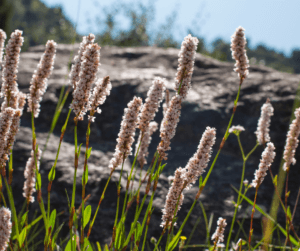
Fernleaf bleeding heart (Dicentra spp.)
One of the few shade-loving perennials with season-long bloom, Dicentra eximia produces flushes of pink flowers from mid-spring through fall. Native to rocky woodland habitats in the mid-Atlantic and Southeast, it’s nearly identical with the Western U.S. native Dicentra formosa. Their charming blooms cluster above low clumps of ferny, often silver-tinged leaves, which are quite attractive in their own right. Hybrids between these species (including ‘Zestful and ‘Luxuriant’) also make outstanding and pest-resistant garden subjects.


